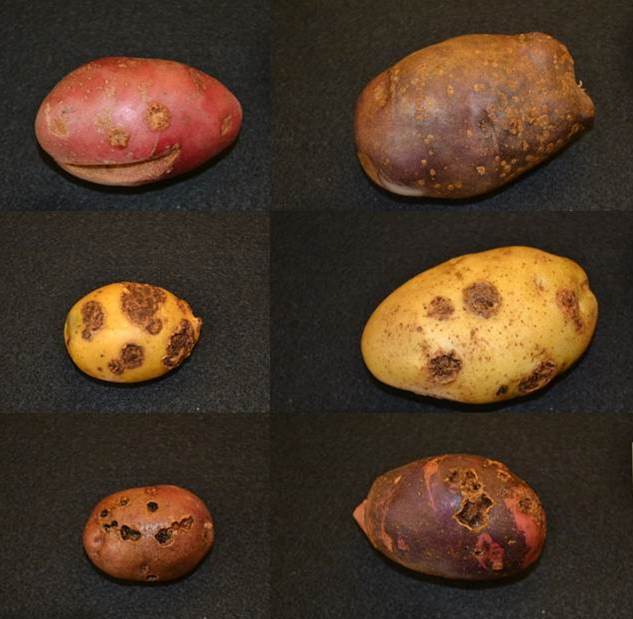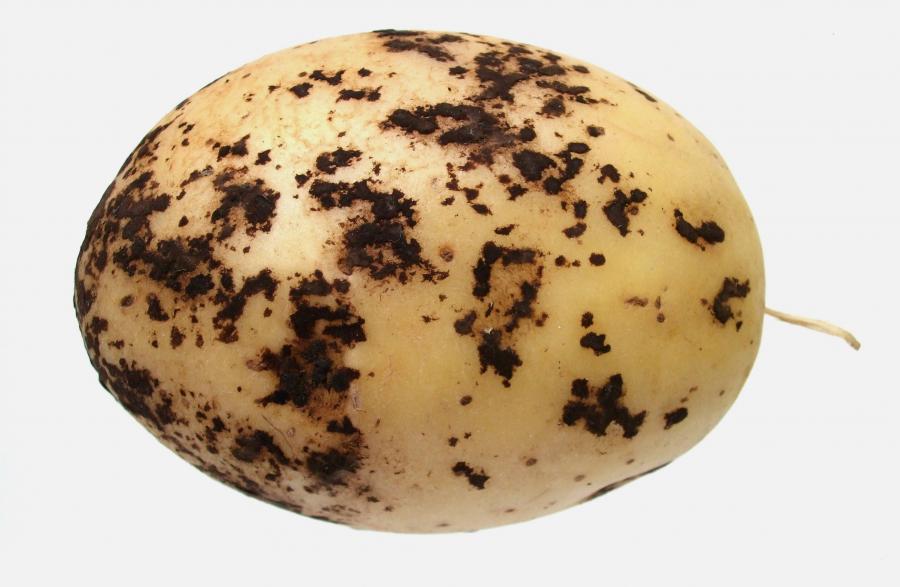Evaluating harvested tubers – surface disease defects
Culling harvested produce (sorting it into marketable and unmarketable lots) can be a process with the simple criterion “would my customers buy/eat this vegetable?” During the culling process, you can collect valuable information about the causes of defects in produce, information that will be useful in making variety choices and management choices. For example, if you notice high levels of common scab in a lot of potatoes, you might decide to rotate the field they came from out of root vegetables for several years, to try a bio-fumigant cover crop, or to look for scab-resistant varieties in future. You don’t have to become an expert in vegetable disease symptoms – County and State extension agents will give you advice based on photographs or samples of suspect produce, and many state universities have plant disease diagnostic laboratories to which you can submit samples (usually for a small fee; see resources below). However, the three most common surface diseases on potato tubers are easy to recognize, and if you are participating in our variety trials, you might see differences between varieties for the prevalence and severity of these diseases:
Common scab – this is caused by a soil bacterium, Streptomyces scabies. The bacteria infect the skin of the tuber, causing scabby lesions on its surface. Lesions may be deep (“pitted scab”) or superficial (“russet scab”). Some potato varieties have moderate to good resistance to common scab. Common scab can affect root crops such as beets and carrots, so consider this when planning rotations. Consistent soil moisture, a soil pH at or below 5.2, and planting clean seed assist in controlling common scab.

Silver scurf – this is caused by a soil-dwelling fungus, Helminthosporium solani. The silvery or golden appearance of the lesions on the tuber surface is due to air pockets under the skin where the fungus has killed cells. Symptoms are more obvious on red or blue skinned potatoes but can also be seen on yellow and white skinned potatoes. Lesions can increase in storage, and spores can spread to other stored tubers. There is little to no resistance to silver scurf in cultivated potato varieties. Harvest tubers soon after skin set, since the fungus will grow and produce lesions on tubers as long as they remain in the soil. Use clean seed, practice crop rotation, and control volunteer potatoes to reduce silver scurf inoculum in fields.

Black scurf – this is caused by a soil-dwelling fungus, Rhizoctonia solani. Tubers show black raised masses (sclerotia) on tuber surface – “the dirt that doesn’t wash off”. The sclerotia can be scratched off but this may damage the tuber skin. The fungus will also attack underground sprouts and stolons – they can be girdled and killed. To control black scurf, plant clean seed into warm soil, and practice crop rotation. Harvest tubers soon after skin set, since sclerotia form as vines begin to senesce.

US Midwest resources for plant disease diagnosis:
Often the first step in diagnosing a plant health problem is to contact your county extension agent, to benefit from their experience and their knowledge of other farms in your county. If you need further help with diagnosis, your state may have a vegetable pathology program or extension specialist. Plant disease diagnostic laboratories in the Midwest include:
North Dakota State University Plant Diagnostic Lab (www.ag.ndsu.edu/pdl)
South Dakota State University Plant Diagnostic Clinic (www.sdstate.edu/ps/plant-clinic/)
University of Minnesota Plant Disease Clinic (pdc.umn.edu/)
Iowa State University Plant and Insect Diagnostic Clinic (www.ent.iastate.edu/pidc/)
University of Wisconsin Plant Disease Diagnostic Clinic (labs.russell.wisc.edu/pddc/)
Michigan State University Diagnostic Services (www.pestid.msu.edu/)
University of Illinois Plant Clinic (web.extension.illinois.edu/plantclinic/)
Purdue University Plant & Pest Diagnostic Laboratory (www.ppdl.purdue.edu/)
Ohio State University Plant and Pest Diagnostic Clinic (ppdc.osu.edu/)
This article was posted in Blog Posts and tagged black scurf, common scab, potato variety trials, silver scurf, tuber diseases.
Comments are closed.